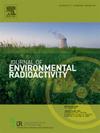2021年至2024年福岛第一核电站周围海洋鱼类及其宿主海水中的氚和137Cs水平
IF 2.1
3区 环境科学与生态学
Q3 ENVIRONMENTAL SCIENCES
引用次数: 0
摘要
我们研究了2021-2024年福岛第一核电站(FDNPP)周围海洋鱼类和同时收集的宿主海水中氚和铯-137 (137Cs)活性的分布。从2021年4月到2023年6月(经过多核素去除设施处理的水首次排放到海洋之前,以下简称“排放之前”),近海(距离FDNPP 5公里)收集的底层鱼类宿主水的平均氚活度为0.085 Bq/L。在近岸水域(FDNPP以南2 km),氚活度在2021年和2022年随河流输入而变化,并与溶解的137Cs相关。在2023年8月处理水开始释放后(以下简称“释放后”),在近海和近岸站点,几个样品偏离了释放前氚与溶解137Cs的线,反映了处理水衍生氚的输入。放生前,岩鱼和比目鱼体内组织游离氚(TFWT)活性均值分别为0.089和0.075 Bq/kg-鲜,放生后分别为0.081和0.13 Bq/kg-鲜。近岸放生后比目鱼TFWT活动为0.37 ~ 0.75 Bq/kg-鲜。释放后TFWT活性升高可能是由宿主海水中氚活性升高引起的。然而,在释放前后,TFWT与宿主海水氚的浓度比(CRs)没有差异,表明TFWT对宿主水中氚的变化反应迅速。此外,释放后近海岩鱼和日本比目鱼的TFWT +总有机结合氚的cr值为1或更低,表明氚没有在海鱼体内积累。本文章由计算机程序翻译,如有差异,请以英文原文为准。
Tritium and 137Cs levels in marine fishes and in their host seawater around the Fukushima Daiichi Nuclear Power Plant from 2021 to 2024
We examined distributions of tritium and cesium-137 (137Cs) activity in marine fishes and in simultaneously collected host seawater in 2021–2024 around the Fukushima Daiichi Nuclear Power Plant (FDNPP). From April 2021 to June 2023 (before water treated by a multi-nuclide removal facility was first released into the ocean, hereafter, “before releases”), the mean tritium activity in bottom layer, host water of fishes, collected offshore (>5 km from the FDNPP) was 0.085 Bq/L. In nearshore water (2 km south of the FDNPP), tritium activity varied with fluvial input in 2021 and 2022 and correlated with dissolved 137Cs. After the start of treated-water releases in August 2023 (hereafter, “after releases”), at both offshore and nearshore sites, several samples deviated from the line of tritium vs dissolved 137Cs before releases, reflecting the input of treated-water-derived tritium. Means of tissue-free-water tritium (TFWT) activities in rockfish and Japanese flounder at offshore site were 0.089 and 0.075 Bq/kg-fresh, respectively, before releases, and 0.081 and 0.13 Bq/kg-fresh, respectively, after. At nearshore site, Japanese flounder TFWT activities after releases were 0.37–0.75 Bq/kg-fresh. The elevated TFWT activities after releases could have been caused by elevated tritium activities in host seawater. There, however, was no difference in the concentration ratios (CRs) of TFWT to host seawater tritium between before releases and after releases, indicating that TFWT quickly responded to changes in host water tritium. Moreover, the CRs of TFWT + total organically bound tritium for rockfish and Japanese flounder offshore after releases were 1 or less, suggesting that tritium was not accumulated in marine fish.
求助全文
通过发布文献求助,成功后即可免费获取论文全文。
去求助
来源期刊

Journal of environmental radioactivity
环境科学-环境科学
CiteScore
4.70
自引率
13.00%
发文量
209
审稿时长
73 days
期刊介绍:
The Journal of Environmental Radioactivity provides a coherent international forum for publication of original research or review papers on any aspect of the occurrence of radioactivity in natural systems.
Relevant subject areas range from applications of environmental radionuclides as mechanistic or timescale tracers of natural processes to assessments of the radioecological or radiological effects of ambient radioactivity. Papers deal with naturally occurring nuclides or with those created and released by man through nuclear weapons manufacture and testing, energy production, fuel-cycle technology, etc. Reports on radioactivity in the oceans, sediments, rivers, lakes, groundwaters, soils, atmosphere and all divisions of the biosphere are welcomed, but these should not simply be of a monitoring nature unless the data are particularly innovative.
 求助内容:
求助内容: 应助结果提醒方式:
应助结果提醒方式:


